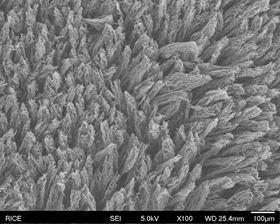 This scanning electron microscope image shows a composite of laser-induced graphene and polystyrene. Image: Tour Group/Rice University.
This scanning electron microscope image shows a composite of laser-induced graphene and polystyrene. Image: Tour Group/Rice University.Laser-induced graphene (LIG), a flaky foam of atom-thick carbon, has many interesting properties on its own, but gains even more powers as part of a composite. In a paper in ACS Nano, the labs of James Tour, a chemist at Rice University, and Christopher Arnusch, a professor at Ben-Gurion University of the Negev in Israel, report a batch of LIG composites that put the material's abilities into more robust packages.
By infusing LIG with plastic, rubber, cement, wax or other materials, the labs made composites with a wide range of possible applications. These new composites could be used in wearable electronics, in heat therapy, in water treatment, in anti-icing and deicing coatings, in creating antimicrobial surfaces and even in making resistive random-access memory devices.
The Tour lab first made LIG in 2014 when it used a commercial laser to burn the surface of a thin sheet of polyimide, a common plastic; the laser's heat turned a sliver of the material into flakes of interconnected graphene. This one-step process produced much more graphene, and at far less expense, than is possible with chemical vapor deposition, a conventional method for synthesizing graphene.
Since then, the Rice lab and others have expanded their investigation of LIG, even replacing the polyimide with wood and food (see Graphene displays labeling abilities on toast, coconuts and potatoes). Last year, the Rice researchers created graphene foam for sculpting 3D objects (see New foam brings graphene into third dimension).
"LIG is a great material, but it's not mechanically robust," said Tour. "You can bend it and flex it, but you can't rub your hand across it. It'll shear off. If you do what's called a Scotch tape test on it, lots of it gets removed. But when you put it into a composite structure, it really toughens up."
To make the composites, the researchers poured or hot-pressed a thin layer of the second material over LIG attached to polyimide. After the liquid hardened, they pulled the polyimide away from the LIG for reuse, leaving the embedded, connected graphene flakes behind.
Soft composites can be used for active electronics in flexible clothing, Tour said, while harder composites make excellent superhydrophobic (water-avoiding) materials. In addition, applying a voltage causes the 20µm-thick layer of LIG to kill bacteria on the surface, making toughened versions of the material suitable for antibacterial applications.
Composites made with liquid additives are best at preserving the LIG flakes' connectivity. In the lab, these composites heated quickly and reliably when a voltage was applied. This means they should have potential for use as a deicing or anti-icing coating, as a flexible heating pad for treating injuries or in garments that heat up on demand.
"You just pour it in, and now you transfer all the beautiful aspects of LIG into a material that's highly robust," Tour said.
This story is adapted from material from Rice University, with editorial changes made by Materials Today. The views expressed in this article do not necessarily represent those of Elsevier. Link to original source.